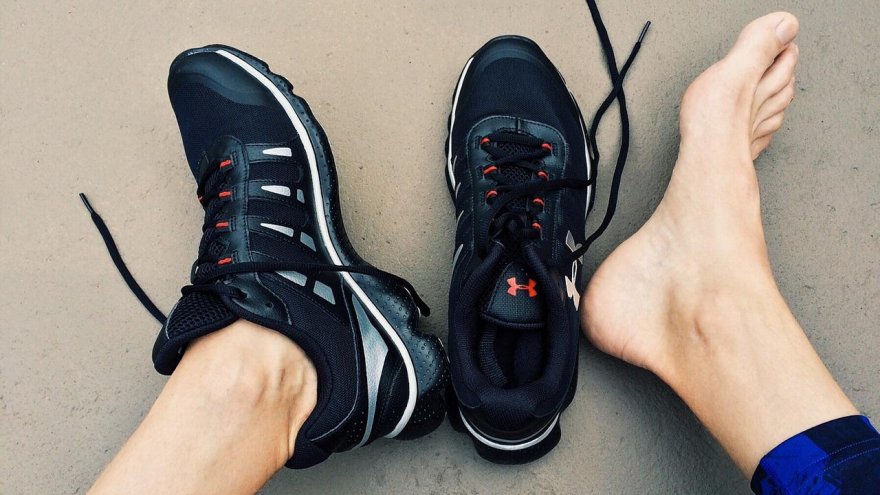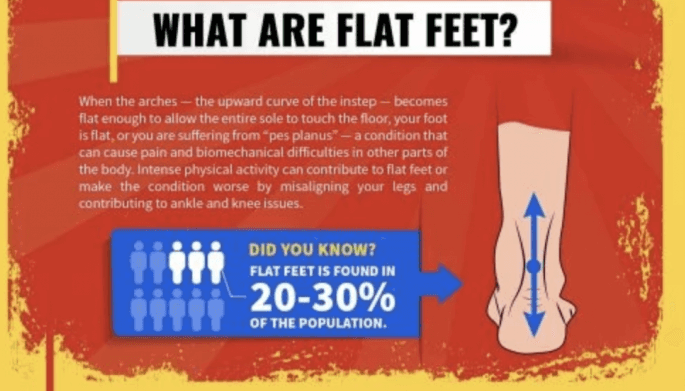How to Fix Flat Feet: Causes, Symptoms, and Treatment

Having flat feet is common, including among runners. Flat feet can predispose you to running injuries, though. But they don’t have to!
This article will review how to tell if you have flat feet and how to fix them. If you do so, you aren’t sidelined from your running passion.
So, let’s roll!
What are flat feet?
Flat feet, also called fallen arches, are exactly what they sound like—the bottoms of your feet are flat in which you have little to no arch. If you have flat feet, the entire soles of your feet touch the floor when you stand up.

There are several causes of flat feet:
- Injuries to the foot or ankle
- Obesity
- Arthritis
- Genetics
- Aging
- Pregnancy
Note: Flat feet from causes such as pregnancy or obesity can be fixed with a lower body mass.
6 ways to know you have flat feet
There are 6 main ways to tell if you have flat feet:
- Flat feet test: Get your feet wet, stand on a surface that will show your wet footprint. Step away and notice if you can see the footprints of the entire bottom of your feet. If you can, then your feet are likely flat. (Your footprint should be narrower along the soles of your feet where the arch is).
- Foot expert: You can have a podiatrist, physical therapist, or even a running shoe salesperson or expert examine where your footfalls when you stand. They can diagnose you with flat feet.
- Imaging: An x-ray or MRI can also diagnose flat feet, also called pes planus.
- Foot pain: If your feet tire easily along the inner sole, feel achy, or swelling in the arches and heels after standing, you may have fallen arches or flat feet.
- Limited toe movement: If you can’t lift your toes easily, you may have flat feet.
- Back, leg, hip, knee, and/or ankle pain: If you suffer from (recurring) injuries related to your back, legs, hips, knees, or ankles, the culprit may lie in fallen arches.
What are the disadvantages of flat feet?
The main disadvantage of flat feet for runners is that they can lead to running injuries. When your entire foot meets the ground, it puts extra pressure on your joints, ligaments, tendons, and muscles, leading to overuse injuries over time.
Also leading to injuries is the overpronation (rolling in) of the foot caused by flat feet, which also puts extra pressure on the joints and soft tissues.
Some injuries that can be linked to flat feet include:
- Heel, foot, ankle, hip, knee, or lower back pain or inflammation
- Rolled in ankles
- Shin splints
- Plantar fasciitis
- Bunions
- Hammertoes
- Arthritis
- Posterior tibial tendon dysfunction (PTTD)
Bear in mind that many runners have flat feet with no problems. If you have fallen arches and no resulting pain, you don’t need treatment or to change anything.
Is it OK to run with flat feet?
It is okay to run with flat feet! In fact, probably millions of people are running with flat feet every day, and many people run with flat feet without issue.
However, if you are experiencing pain in your feet, ankles, legs, knees, hips, or low back because of flat feet, you need proper support and strengthening to guard against pain and injury.
Your feet are ground zero for the high impact of running. So, if they cannot properly absorb the shock, extra pressure is put on the rest of your body, resulting in overuse injuries.
But runners can fix flat feet with proper shoes, insoles, and foot, calf, and ankle strengthening.
Let’s learn more about how to fix flat feet in runners!
Useful tips & shoes
1. Run with proper form.
A physical therapist or shoe salesperson can assess your running form and advise the best running shoes to help control the motion of your foot.
Runners are forefoot, midfoot, or heel strikers. Running shoes can accommodate this footfall pattern to protect against overuse injuries.
When running, assume proper running form to minimize undue stress on your body and wasted energy:
- Maintain a tall posture with your head over hips and feet under your body.
- Avoid overstriding where your foot lands in front of your body.
- Keep your arms swinging by your sides, not across your torso.
- Don’t hunch your shoulders or slouch.
- And, try to have a light and quick foot turnover.
2. Wear proper shoes.
When you have flat feet, your feet and ankles roll in when your foot strikes the ground, called overpronation. It is crucial that runners get shoes that control this excess motion in what is called a stability shoe.
It is also key that a runner with flat feet has arch support to keep the mid-sole from fatiguing.
Here are some of the best running shoes for flat feet:
These flat-foot shoes all offer support, motion control, and cushion. Be sure your shoes fit properly.
Typically, your running shoe size will be a half size bigger than your everyday shoes.
3. Get insoles or orthotics.
There are plenty of arch support insoles. However, you may need to be fitted for customized orthotics to correct the unique structure of your feet.
Ensure the orthotics correct your footfall rather than support it or reinstate it.
Most arch support insoles like Sole or Powerstep cost less than $50. Custom orthotics cost about $250.
If you have flat feet, you may want to try the inexpensive insoles before being fitted by a podiatrist or physical therapist for custom orthotics.
4. Strengthen your feet.
There are several exercises runners can do to add strength to their fallen arches to help fix flat feet. Some of these exercises may include:
Arch lift: Stand with your feet shoulder-width apart. Gently lift your arch of one foot, being careful not to involve your toes by scrunching them.
Repeat 10 times for 3 sets.
Towel curl: With a towel under your toes, curl the towel and hold for 3 seconds. Repeat 10 times for 3 sets.
Calf raises: On a step, drop your heels and raise your body with your tippy toes. Slowly lower back down for about 5 seconds. Repeat 10 times for 3 sets. Do this single leg and add weights when it becomes too easy.
Toe yoga: Standing or sitting, put your feet flat on the ground. Raise just your big toe. Put it back down. Then raise the rest of your toes. Repeat 10 times for 3 sets.
There are also tools such as the Mobo Board designed to strengthen runners’ feet. It is advised to consult with a physical therapist or podiatrist to get the best exercises to suit your specific needs.
5. Stretch.
People with flat feet commonly have shortened Achilles tendons, calf muscles, and tight plantar fascia.
You can alleviate this tightness by:
- doing a calf stretch where you drop your heel off a step
- foam rolling your calves for up to two minutes each leg
- rolling your foot over a golf ball
- pulling back your toes with your hands, and
- looping a belt around your foot with a straight leg and pulling your toes toward you.
6. Run on soft, level surfaces.
Hard surfaces such as concrete increase the impact on your body with each foot strike. Additionally, uneven surfaces put more stress on your feet and ankles.
Aim to run on a track, high-quality treadmill, or soft dirt or asphalt paths.
Running with flat feet and staying injury-free is possible if you take action to protect your body.
Latest Articles
 Is Running on a Treadmill Easier Than Running Outside?Runners have their own preferences, whether it is treadmill running, running outside on the road, or exploring trails. So...
Is Running on a Treadmill Easier Than Running Outside?Runners have their own preferences, whether it is treadmill running, running outside on the road, or exploring trails. So... Is It OK to Use Trail Running Shoes on the Road?While trail running shoes can be used on roads, especially in situations where a runner encounters mixed terrains or pref...
Is It OK to Use Trail Running Shoes on the Road?While trail running shoes can be used on roads, especially in situations where a runner encounters mixed terrains or pref... How to Fix Sore Quads After Running?Rest, ice, gentle stretching, and over-the-counter pain relievers can help soothe sore quads after running. Also, ensure ...
How to Fix Sore Quads After Running?Rest, ice, gentle stretching, and over-the-counter pain relievers can help soothe sore quads after running. Also, ensure ... 10 Fruits With The Most Electrolytes to Replace Sports DrinksThese fruits are high in electrolytes such as potassium, magnesium, and calcium, essential for hydration, muscle function...
10 Fruits With The Most Electrolytes to Replace Sports DrinksThese fruits are high in electrolytes such as potassium, magnesium, and calcium, essential for hydration, muscle function...

